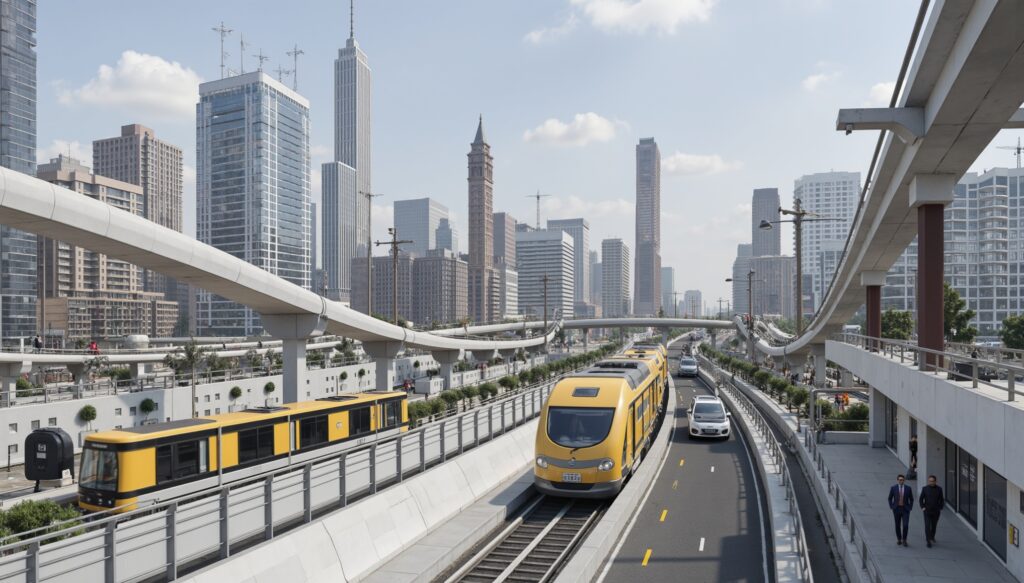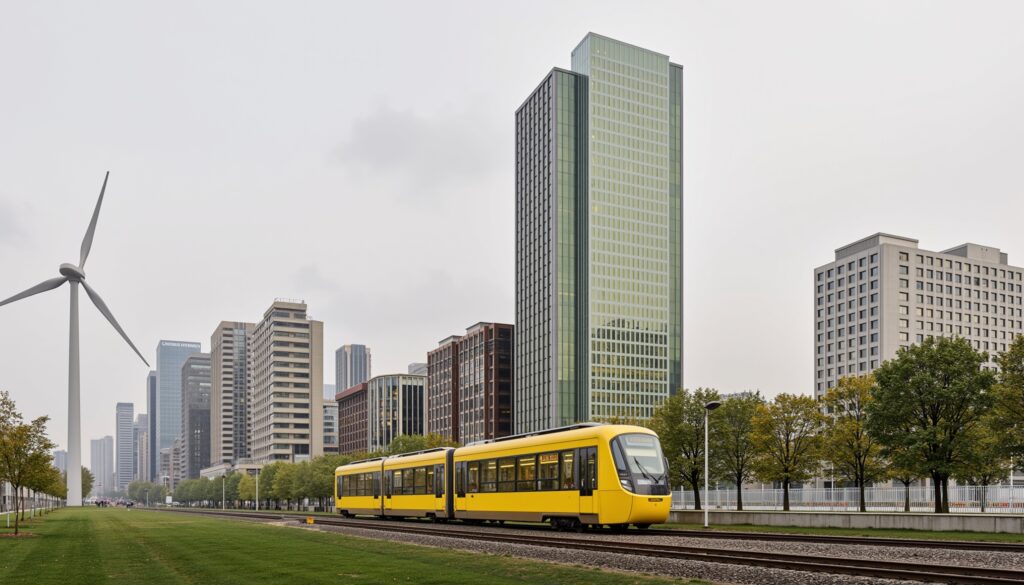Infrastructure development is a cornerstone of economic growth, serving as the backbone for a nation’s progress.
Defined as the construction and improvement of foundational services such as transportation, utilities, and communications, infrastructure is essential for facilitating trade, creating jobs, and boosting productivity.
In this article, we will explore the intricate relationship between infrastructure development and economic growth, examine successful case studies that highlight its impact, discuss challenges that hinder progress, and delve into innovative financing solutions and future trends shaping the landscape of infrastructure development.

Key Takeaways
- Infrastructure development is crucial for fostering economic growth and improving quality of life.
- A strong correlation exists between infrastructure investment and increased productivity in various sectors.
- Successful case studies demonstrate how strategic infrastructure projects enhance regional economies.
- Challenges such as funding, regulatory hurdles, and technological constraints can impede infrastructure advancements.
- Innovative financing solutions and future trends will play a pivotal role in shaping sustainable infrastructure development.
Understanding Infrastructure Development and Its Importance
Infrastructure development is a cornerstone of economic progress, especially in countries like Costa Rica, where significant investment in public works has paved the way for growth in various sectors, including real estate.
Understanding infrastructure development is crucial for potential property buyers and investors, as it directly influences property values, accessibility, and overall quality of life.
In Costa Rica, the government’s commitment to improving transportation networks, utilities, and communication systems not only enhances the living standards of its residents but also attracts foreign investments.
Areas with robust infrastructure tend to experience a surge in real estate opportunities, making it vital for investors to keep an eye on ongoing and future infrastructure projects.
By recognizing the role infrastructure development plays in shaping the real estate landscape, individuals can make informed decisions that align with their investment goals.
The Relationship Between Infrastructure and Economic Growth
Infrastructure development plays a pivotal role in shaping a country’s economic growth.
It encompasses a wide range of facilities, such as transportation systems, telecommunications, and utilities, which are essential for facilitating trade, enhancing productivity, and improving the quality of life for citizens.
When a nation invests in robust infrastructure, it not only creates jobs and stimulates local economies but also attracts foreign investment, further driving growth.
For instance, improved road networks reduce transportation costs for businesses, while advanced communication technologies enable faster and more efficient interactions across various sectors.
As such, a well-developed infrastructure is often seen as a backbone of economic stability and expansion, making it a critical focus for governments and investors alike.
‘Infrastructure is the backbone of any economy; without it, neither growth nor progress would be possible.’ – Unknown

Case Studies of Successful Infrastructure Projects
Infrastructure development in various regions has become a cornerstone of economic growth and community enhancement.
One notable case study is the expansion of public transportation systems in urban areas, which has led to decreased traffic congestion and improved access to employment opportunities.
For example, the implementation of Bus Rapid Transit systems in cities like Bogotá, Colombia, showcased how targeted investments in infrastructure could enhance mobility for residents and reduce travel times significantly.
Another compelling instance of successful infrastructure development is found in Singapore, where the government has initiated extensive projects to improve water management systems.
These efforts not only address the challenges of urban flooding but also highlight the importance of sustainable practices in infrastructure planning.
Such case studies illustrate the transformative power of well-planned infrastructure development, underscoring its role in shaping resilient and sustainable communities.
Challenges and Barriers to Infrastructure Development
Infrastructure development is a critical component for the economic growth of any nation, including Costa Rica.
However, the country faces several challenges and barriers that hinder the advancements necessary for improving infrastructure.
One significant issue is the limited financial resources allocated by the government, which can lead to delays in crucial projects such as road construction and public transportation systems.
Additionally, the bureaucratic processes involved in securing permits and approvals often slow down development efforts, creating frustration among investors and developers.
Environmental regulations, while important, can also complicate infrastructure development, as Costa Rica is renowned for its rich biodiversity and commitment to conservation.
These challenges necessitate a collaborative approach involving both public entities and private stakeholders to devise innovative solutions that balance development needs with environmental stewardship.

Innovative Financing Solutions for Infrastructure Projects
In the ever-evolving landscape of infrastructure development, innovative financing solutions have become essential to address the growing demand for robust and sustainable projects.
Traditional funding methods often fall short in meeting the financial requirements of large-scale initiatives, prompting stakeholders to explore alternative avenues.
Public-private partnerships (PPPs) emerge as a prominent model, combining public oversight with private sector efficiency and investment.
Furthermore, the integration of green bonds has presented a viable option for funding environmentally sustainable infrastructure, promoting projects that not only improve physical assets but also enhance community welfare.
By leveraging these innovative financing approaches, governments can effectively expand their infrastructure capabilities while simultaneously attracting investment and stimulating economic growth.
Future Trends in Infrastructure Development and Economic Growth
Costa Rica is poised for significant advancements in infrastructure development, which will undoubtedly play a crucial role in the country’s economic growth.
As the government focuses on improving transportation networks, enhancing energy generation, and expanding digital infrastructure, these improvements are expected to attract foreign investment and boost tourism.
Projects like the expansion of the Juan Santamaría International Airport and improvements to the nation’s road systems are prime examples of how infrastructure development is being prioritized.
Furthermore, the shift towards sustainable practices, such as eco-friendly transportation options and renewable energy resources, not only supports the country’s commitment to environmental conservation but also positions Costa Rica as a leader in sustainable development.
Investing in infrastructure is essential for enhancing the quality of life for residents and creating a more conducive environment for business expansion.
As these developments unfold, it will be fascinating to observe how they reshape Costa Rica’s economic landscape, making it an even more attractive destination for real estate investment.
Frequently Asked Questions
What is infrastructure development?
Infrastructure development refers to the planning, construction, and upgrading of essential systems and structures that support economic activities, including transportation networks, utilities, communication systems, and public facilities.
How does infrastructure development influence economic growth?
Infrastructure development plays a crucial role in facilitating trade, enhancing productivity, attracting investments, and creating job opportunities, all of which contribute to overall economic growth and development.
Can you provide examples of successful infrastructure projects?
Yes, notable examples include the development of the Interstate Highway System in the United States, high-speed rail networks in Japan and Europe, and renewable energy projects in countries like Germany, which have significantly boosted their economies.
What are some challenges faced in infrastructure development?
Challenges include inadequate funding, regulatory hurdles, political instability, and environmental concerns, which can hinder the planning and implementation of infrastructure projects.
What are future trends in infrastructure development?
Future trends include the integration of smart technologies, a focus on sustainability and resilience, increased public-private partnerships, and innovative financing solutions to meet the growing demands of urbanization and climate change.





